There are two modes of time, according to the Greeks: Chronos and Kairos. Chronos is the slow and steady inching forward of work, work, work. But Kairos opens up a moment of revelation, an evolutionary leap that frames the work of the past while cracking open a radically new future. Brompton Bicycle celebrates its 50th anniversary in 2025, and it is bringing Canada some revolution along with the revelation. First, there’s the G-Line. Brompton calls the new larger-wheeled Brompton G-Line “the brand’s biggest innovation in 50 years.” But the other story is the introduction of the MK6 frame and wider-gearing across the entire 2025 line-up. While Brompton will never stop inching forward, 2025 is one overhaul of a year.
Planned Unobsolescence
While 2025 marks a revolutionary year for Brompton, such revolutionary talk must be checked. Brompton is a wildly interesting company and for Brompton, the new never erases the old. Different years of Brompton models might become outdated, but they never become obsolete. One thing that makes Brompton very special is that it creates what product designers call a “Legacy Compatible Design.” That’s why most parts from the current model year will famously interchange – and upgrade – Bromptons that are decades older. Of course, we’re talking about the original 16″ wheeled bike. Interested in the new G-Line? Skip ahead to this article.
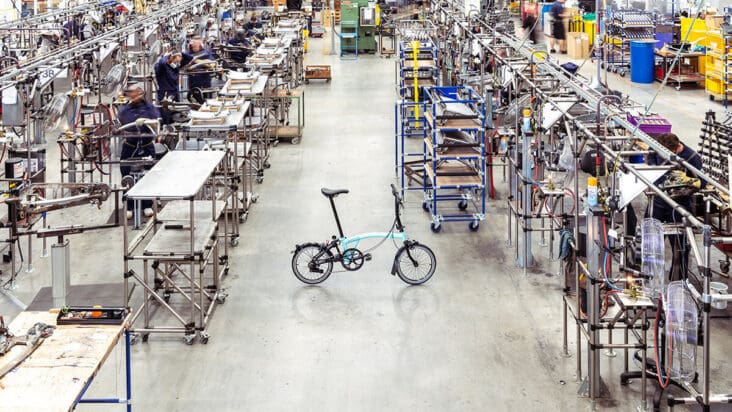
Gearing on the original 16″ wheeled bike is one such area. Before 2008, Brompton used a conventional 3-speed internal gear hub on their bikes. This hub was largely designed for heavy Dutch bikes and had limited range on a Brompton, especially when climbing. In 2008, Brompton collaborated with Sturmey-Archer, the maker of these hubs, on a wider-range hub called the BWR (Brompton Wide Range). The BWR hub meant that the Brompton had a half-decent range of gears. What makes the 2025 models special is that they improve this by another half. In 2025, suddenly a Brompton can do anything.
Big Swings in the Swingarm
The difference between the 2025 16″ wheeled Brompton and all previous models is the introduction of the MK6 rear frame or “swing arm.” This, as we shall see, has everything to do with expanding the gear range of the Brompton. The rear frame or swing arm on a Brompton is that rear part of the frame that connects the main frame of the bike to the wheel. It also connects the rear brakes, and some rear gearing components. A glance at Brompton’s history reveals that changes in the rear frame or swing arm usually coincide with big revolutionary years for Brompton. We’ll keep the history lesson short!
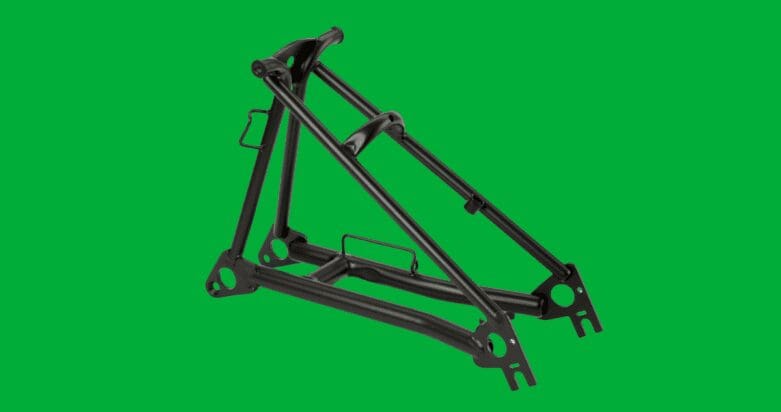
In 1983, the MK2 swing arm marked the shift from Brompton as a prototype to a production bike. That’s a pretty big deal. Then, in 1987, Brompton introduced the MK3 rear frame. This rear frame vastly increased the bike’s wheelbase to the stable yet agile design we know today. In 2006, Brompton launched new, revolutionary wider-range gear hubs and, with them, the MK4 rear frame. This MK4 swing arm served Brompton for nearly 20 years until the MK5 rear frame was introduced. The MK5 was launched to serve the Brompton Electric bike — another massive revolution.
The MK6 – a 2025 Revolution
Everything changes, however, with the recent introduction of the MK6 rear frame. What makes the MK6 different? The MK6 rear frame is significantly wider than all previous swing arms. This allows Brompton to attach more rear cogs – and thus significantly more gear range – to the rear wheel. This ability to flatten hills was always missing on previous Brompton models. What do all the 2025 Brompton 16″ wheeled models have in common? They all use the MK6 rear frame. Thus, in one fell swoop everything that precedes the MK6 frame is immediately outdated, though certainly not obsolete.
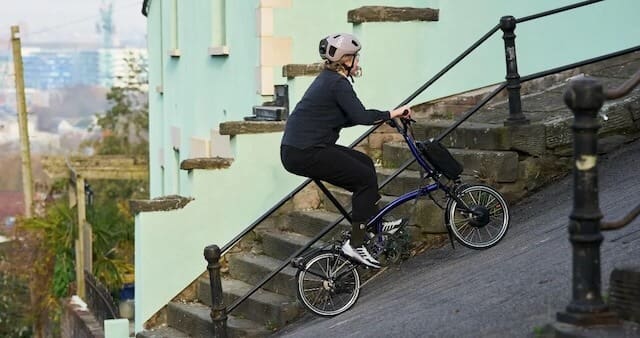
Why wasn’t the MK5 frame good enough? It’s a good question. Developing the Electric bike forced Brompton to seriously assess the question of use-case. Previously, Brompton offered a two-speed system and a six-speed system. The six-speed was really a Brompton Wide Range (BWR) 3-speed hub used in conjunction with a two-speed derailleur. Two times three equals six, therefore six speeds. The BWR hub is a genius piece of Brompton engineering that continues, in spirit at least, from the MK5 to MK6 models. (Note that the guts are the same, but the axle length of the BWR on the MK6 is significantly wider).
Improving the Past
Now, the problem with gear hubs is that they tend to weigh in correspondence to the number of gears they have. Thus, a three-speed hub weighs a lightweight three pounds, while an eight-speed hub weighs a hefty eight. The issue with a folding bike’s use-case is that it needs to be carried when folded, so any extra weight matters.
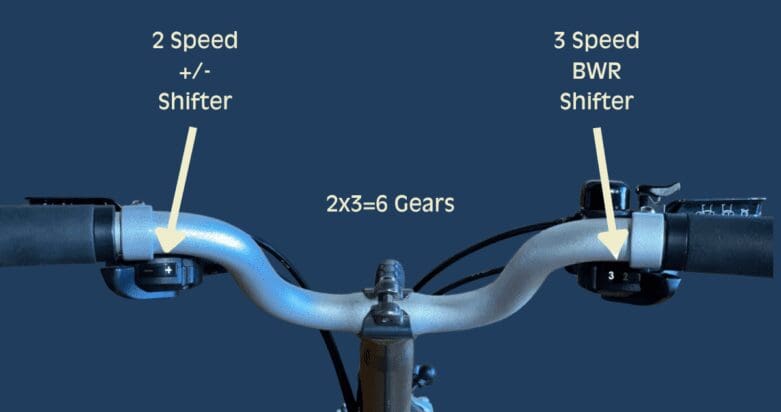
The genius of the BWR 3-speed hub is that it has roughly the same gear range as an eight-speed hub, but with none of the extra weight. The problem, however, is that the jump from each gear tends to be quite big, begging the question: could there please be some gears in between? And this is what the two-speed addition helped resolve. If you jump from gear 1 to gear 2 on the BWR hub and find the jump too much of a leap, the two-speed shifter can fill in some of the gaps. It’s pretty smart.
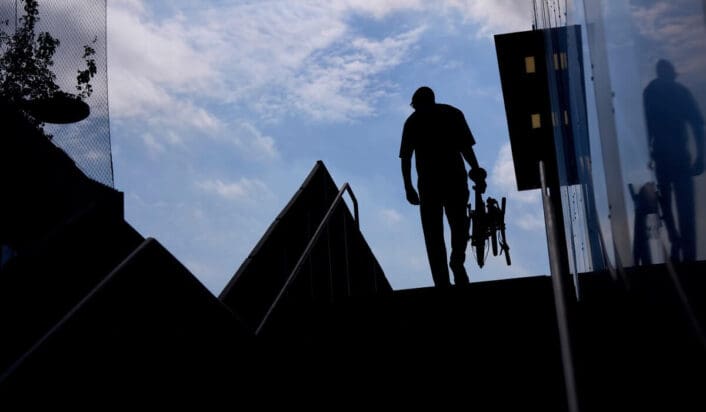
What wasn’t so smart was the 2-speed bike that came out of this. The two-speed worked great with the BWR 3-speed hub, and the BWR 3-speed hub worked great with the two-speed, but on their own, they were each pretty useless. While the gap between each gear on the BWR 3-speed hub was too massive to be used alone, the gap between each gear on the two-speed derailleur was too small to really offer much of a difference. Nonetheless, Brompton introduced a two-speed version of their C-Line “Urban” bike that, in truth, never sold all that well. It’s clear Brompton knew this too; hence the new 2025 models.
Prelude: It’s all in the Numbers
What was good about the two-speed, however, is that it was light. The problem that the Electric model introduced is that the motor and battery were beginning to push the bike out of that “sweet spot” when carrying the bike folded. Making the Electric bike lighter by using titanium in the frame was one solution; but it jacked up the price. Another solution was to build a wider gear system that didn’t necessarily have to employ the heaver BWR hub. And this is where the MK6 rear frame enters the picture. The MK6 provides a lightweight 4-speed bike for those who wanted something lighter, and a 12-speed bike for those who still wanted that BWR hub for the widest gear range possible. To help illustrate, we’re going to bring this down to some good ol’ numbers.
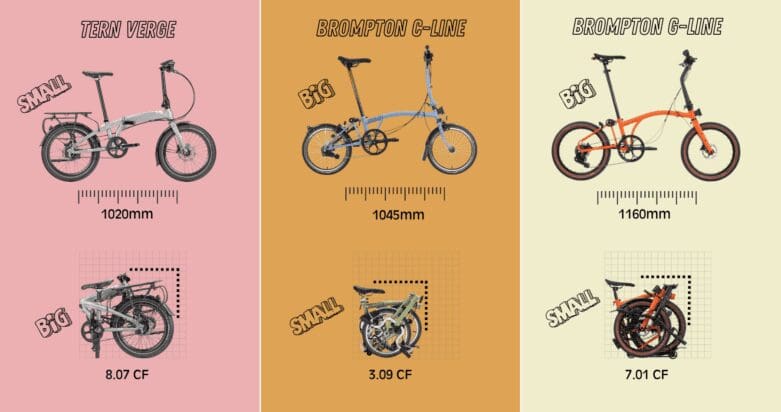
We’ve always found that numbers best help explain why a Brompton is better. For instance, when you’re buying a folding bike, you’ll want something that unfolds to a long wheelbase for ride stability yet folds small for carrying. Thus, a good folding bike must measure big on the unfold yet small on the fold. All of this is measurable. A 16″ wheeled Brompton folds to a tiny 3 cubic feet yet unfolds to a 1045mm wheelbase. A competing bike, like the Tern Verge, folds to a ghastly 8 cubic feet and yet still unfolds to a twitchy 1020mm wheelbase. But enough about that—time to discuss gears!
Inching Forward: A Matter of Speed(s)
Gears too can be expressed by numbers. And, these are called Gear Inches. While we won’t get into the math behind Gear Inches (you can read more about that here), the lower the gear inch number, the better you can climb, and the higher the gear inch number, the faster you can go. The following chart helps show how Brompton has been slowly inching its way toward the optimal gear range with the introduction of the MK6 rear frame. A big thanks to the maker of the Brompton Gear Calculator for providing the data.
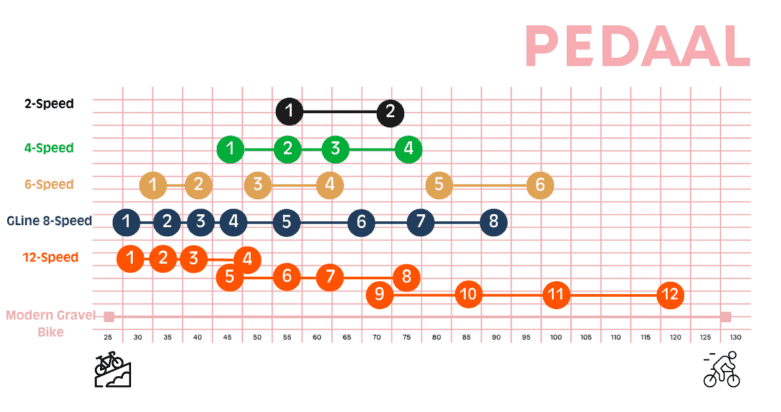
At the bottom of the graph, we have a modern hybrid or gravel bike. These bikes tend to face all kinds of friction—gravel, asphalt, dirt—and all kinds of topography. Thus, these bikes tend to have the widest gears in the bicycle business and form an archetype of sorts. As one can immediately see, the Brompton 12-speed bike—which employs the 3-speed BWR hub and a four-speed derailleur—nearly matches a gravel bike for range. That’s incredible.
But, what kind of use-case demands a Brompton with so much gear range? Clearly, someone who plans longer rides—whether a hilly commute or a multi-hour adventure. This is especially important for the Brompton Electric bike. Anyone riding all-day distances on a Brompton Electric is obviously concerned about battery range. Having a wide gear selection means that the motor is not “used as though it was a gear,” which drains battery life and increases range anxiety. The best way to illustrate this is to compare the 12-speed to the 4-speed. If you were doing longer rides on the 4-speed Electric and encountering big hills, you’d lack the same low climbing gears as the 12-speed. Thus, you would have no choice but to crank up the motor’s power. And, this sucks away precious battery juice.
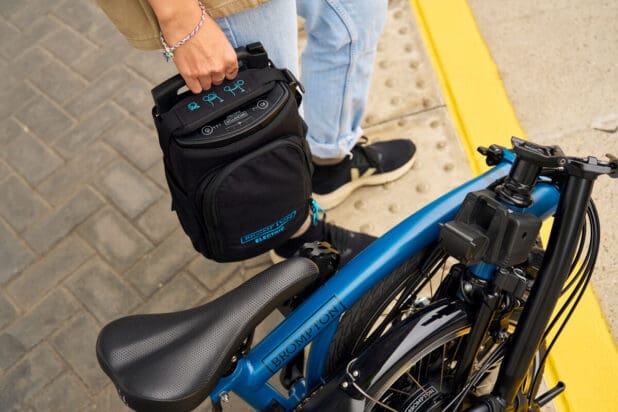
So, who is the 4-speed for? The 4-speed is for anyone who wants a lighter bike, rides less mountainous terrain, and doesn’t have a reason to worry about battery range. With a battery range of up to 70km, the 4-speed Electric is for a city cyclist who still enjoys a longer adventure, isn’t crazy about sweating up big hills, and perhaps needs to carry the bike in its folded mode up several flights of stairs. The 4-speed non-electric buyer enjoys the lighter weight, the lack of complexity with the gears, and, if faced with a big hill, loves that spin-class moment that brings on some sweat. What’s great about the 4-speed is that it replaces the old 2-speed bike with something that makes a heck of a lot more sense.
The G-Line
Of course, the biggest change Brompton brings to 2025 is the launch of their G-Line bike. We’ve written extensively about the G-Line and even purchased an advance model so you can try it out first.
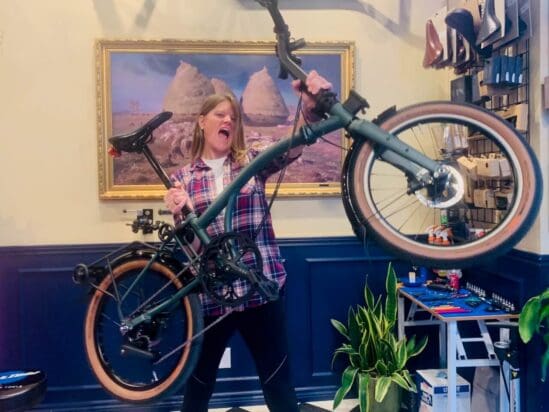
Who is the G-Line for? To answer, let’s go back to the origin of the Brompton bike—a question of use-case. The original 16″ wheeled Brompton bike was designed for a London train commuter who needed something small that could squish onto the London Tube, unfold to a stable yet agile wheelbase to conquer London streets, and transfer from fold to unfold quickly and easily.
Just Plane Fun
What Brompton didn’t realize when building the original model is how easy it is to also take on a plane. That means a Brompton could be the perfect bike to ride to work and store at work (answering the problem of theft), but also the perfect bike to ride around NYC or Paris after a short flight. We like to call this the bonus level of buying a Brompton—if it’s already the perfect city bike, it’s also the perfect companion on vacation.
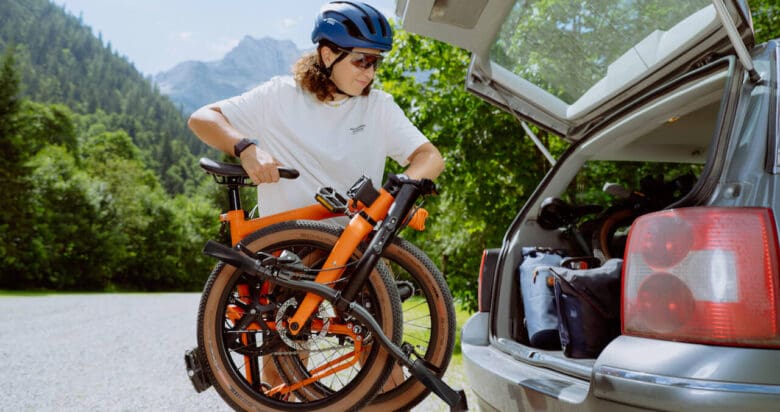
However, what all of the above has in common is what we’ll call intra-city travel—riding around within a city. Whether in your own city or a city you’ve traveled to, the original 16″ wheeled Brompton is the best way to get around. But what if you want to ride outside the city—especially off the road on trails or gravel? Or what if you want to do a proper inter-city bike tour and ride from city to city? This is where the G-Line does better work than the original 16″ wheeled Brompton.
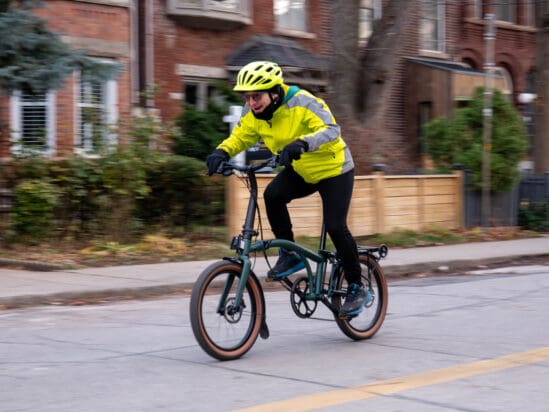
That being said, our first rides on the G-Line have us convinced that its wider tire and even longer wheelbase offer compelling arguments against the original 16″ wheeled Brompton. Sure, its folded size may be bigger, but it’s no less manageable than the original 16″ wheeled Brompton when it comes to carrying or storing.
In Conclusion
Anyone familiar with Brompton knows that their bike has been a non-stop obsession since inception. Part of this obsession is a commitment to non-obsolescence. In 2025, their anniversary year, Brompton introduces the revolutionary G-Line and a gearing system that radically improves, if not immediately outdates, older years of the original 16″ model. Interested in learning more? Check out our Brompton selection, shoot us an email at info@pedaal.com, and don’t hesitate to book a sales appointment here!




